EigenLayer and Ether.fi have both transformed. Can the staking track business no longer be continued?
In the first half of 2024, the concept of secondary yield stirred up the market, and “re-staking” once became the core topic sweeping through the crypto ecosystem. EigenLayer rose, with projects like Ether.fi and Renzo emerging one after another, and re-staking tokens (LRT) blossoming everywhere.
However, both leading projects in the current track have chosen to transform:
- Ether.fi announced its transformation into a crypto neobank, planning to launch cash cards and staking services aimed at US users.
- Eigen Labs announced a layoff of about 25%, restructuring resources to fully focus on the new product EigenCloud.
The once booming “re-staking” is now at a turning point. Do the strategic adjustments of the two major players signify that this track is heading towards obsolescence?
Emergence, craze, and clearing
In the past few years, the re-staking sector has experienced a cycle from conceptual testing to a surge of capital influx.
According to RootData, there are currently over 70 projects that have emerged in the re-staking sector. EigenLayer, part of the Ethereum ecosystem, is the first project to bring the ReStaking model to market, leading to a collective explosion of liquidity re-staking protocols such as Ether.fi, Renzo, and Kelp DAO. Subsequently, new architecture projects such as Symbiotic and Karak have also appeared.
In 2024, financing events surged to 27, raising nearly $230 million throughout the year, making it one of the hottest sectors in the cryptocurrency market. As we enter 2025, the pace of financing begins to slow down, and the overall excitement in the sector gradually cools.
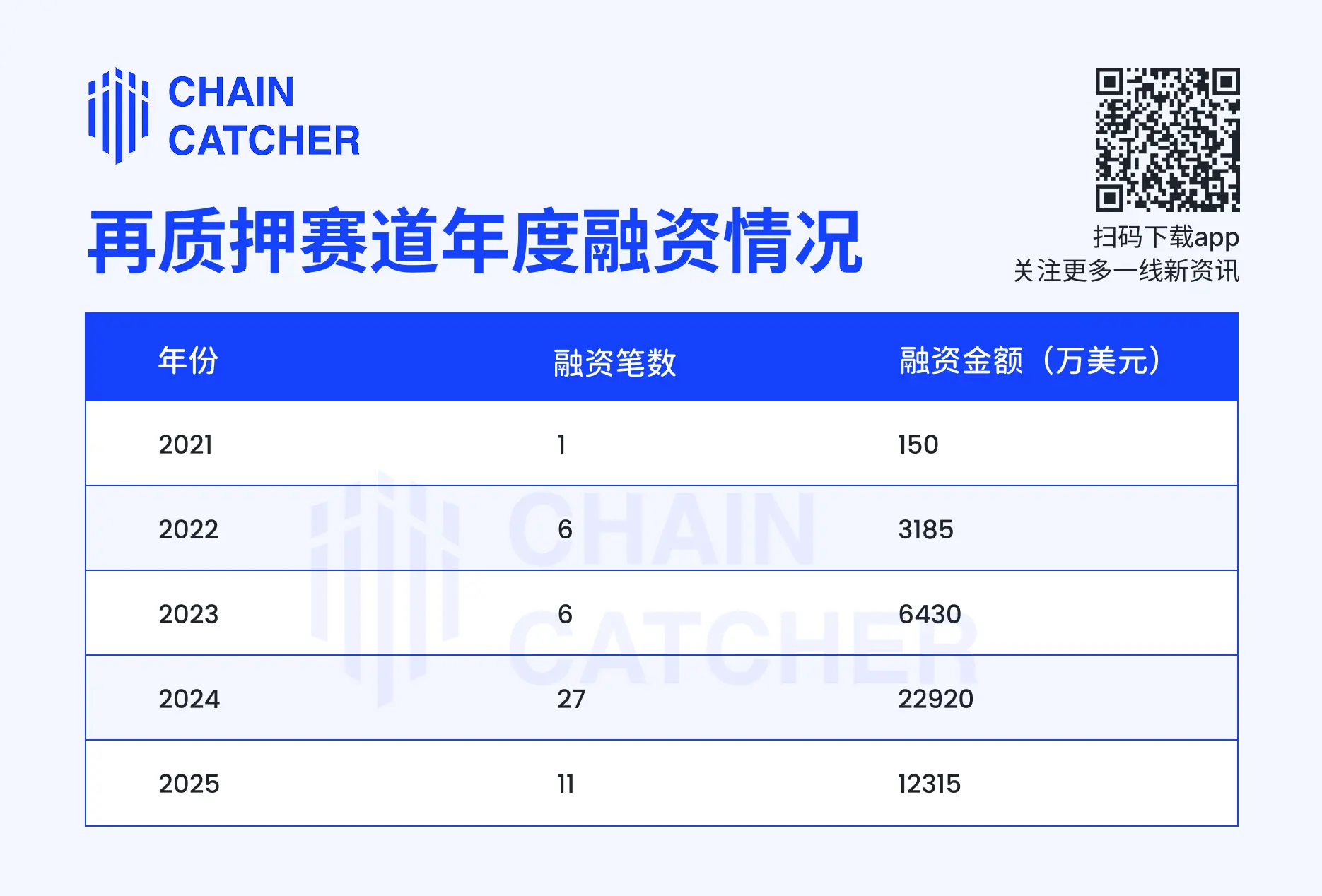
At the same time, the reshuffling of the track is accelerating. Currently, 11 projects including Moebius Finance, goTAO, and FortLayer have successively ceased operations, and the early bubble is gradually being cleaned up.
Currently, EigenLayer remains the leader in the race, with a TVL of approximately $14.2 billion, accounting for over 63% of the market share in the entire industry. Within its ecosystem, Ether.fi holds about 75% of the share, while Kelp DAO and Renzo account for 12% and 8.5%, respectively.
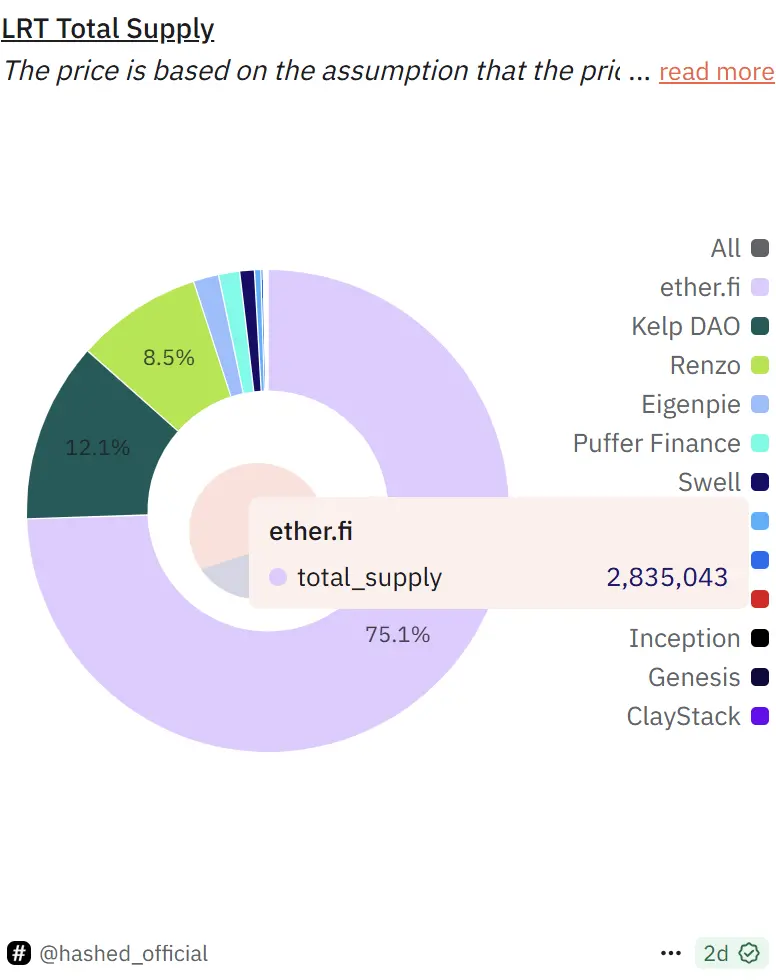
Narrative Weightlessness: Cooling Signals Behind the Data
As of now, the total TVL of the re-staking protocol is approximately $22.4 billion, down 22.7% compared to the historical peak in December 2024 (approximately $29 billion). Although the overall locked amount remains high, signs of a slowdown in the growth momentum of re-staking have emerged.
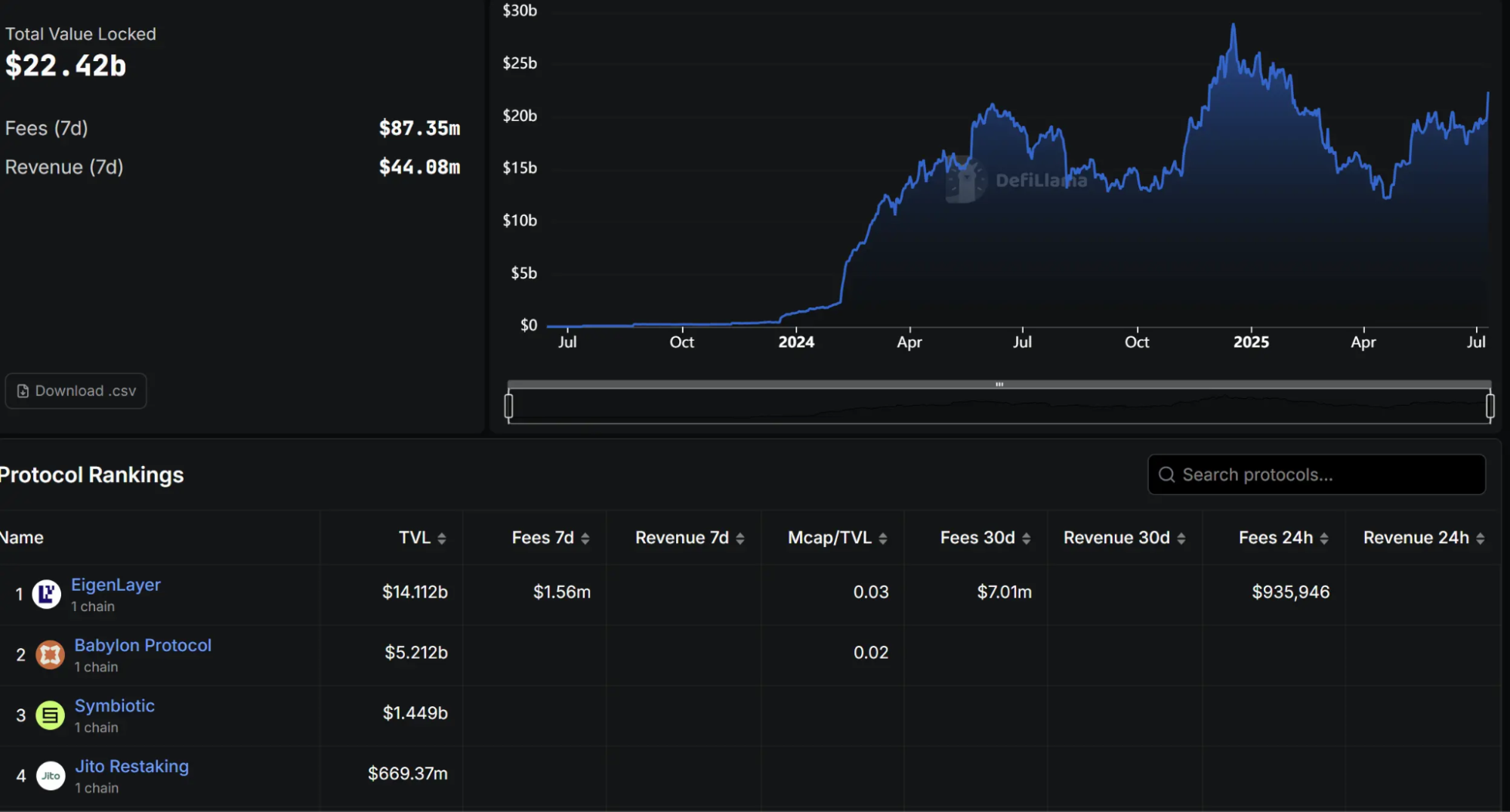
Image source: Defillama
The decline in user activity is becoming more pronounced. According to data from The Block, the daily active deposit users for Ethereum’s liquidity staking have plummeted from a peak of over a thousand in July 2024 to just over thirty currently, while the number of daily unique deposit addresses for EigenLayer has even fallen to single digits.
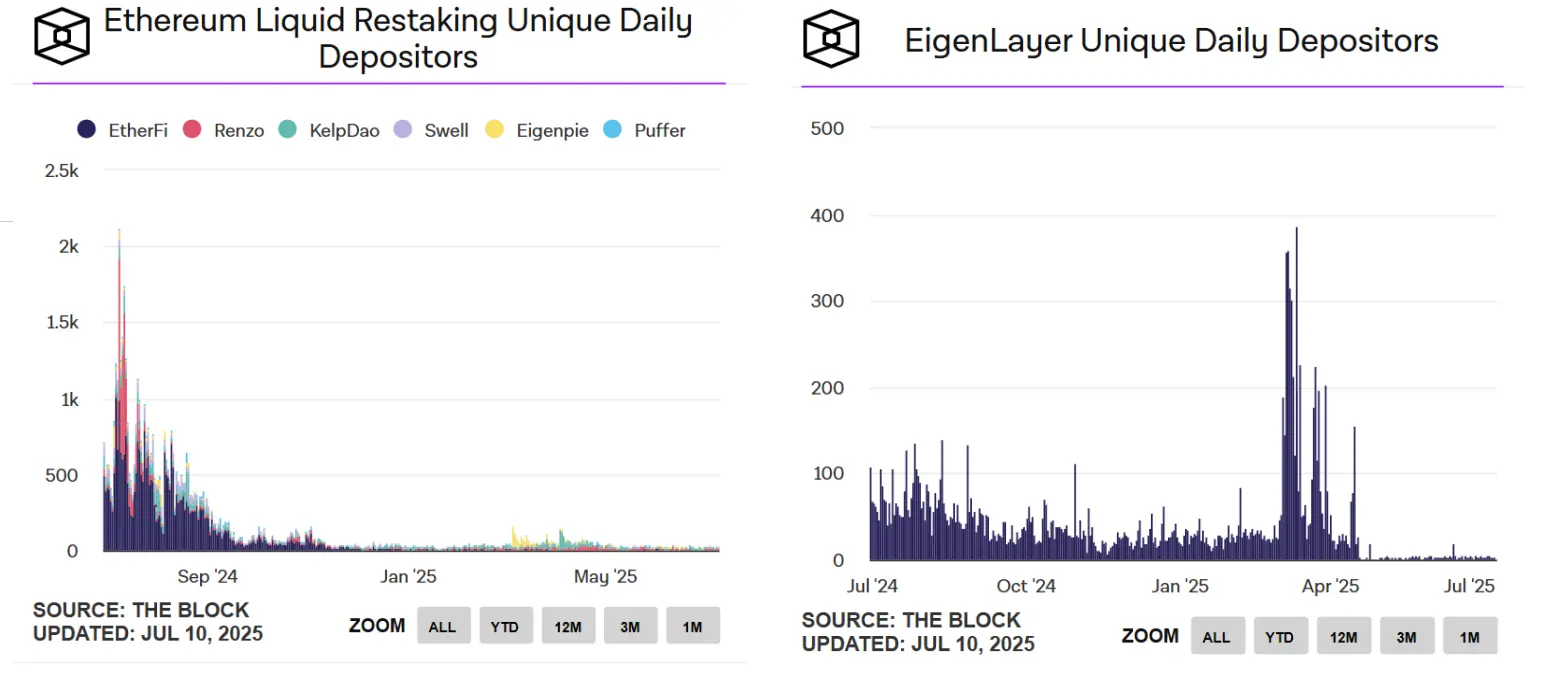
Image source: The Block
From the perspective of validators, the appeal of re-staking is also diminishing. Currently, the daily active re-staking validators on Ethereum account for less than 3% compared to regular staking validators.
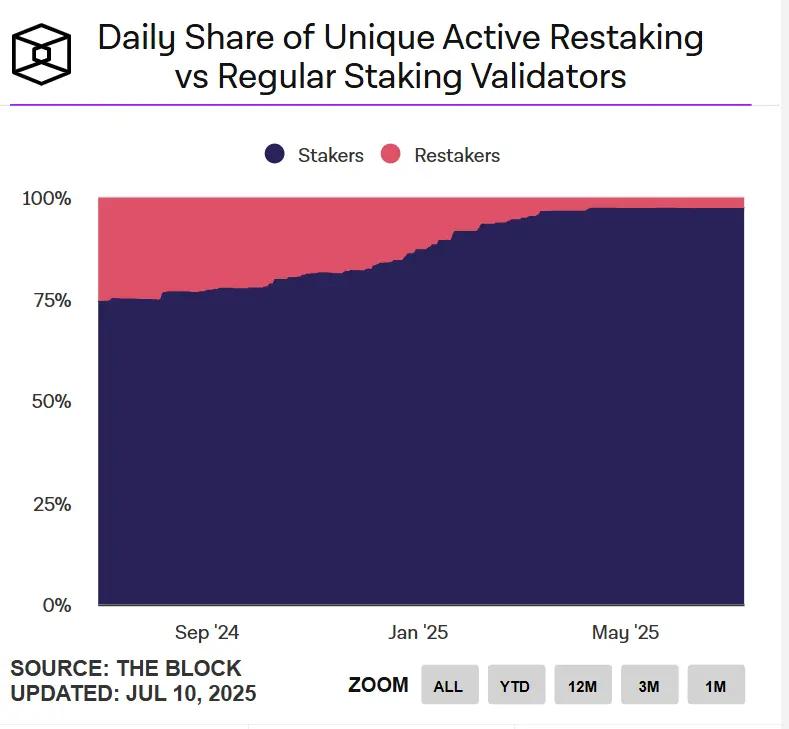
In addition, the token prices of projects such as Ether.fi, EigenLayer, and Puffer have all corrected more than 70% from their highs. Overall, although the re-staking sector still retains a certain scale, user activity and participation enthusiasm have significantly declined, and the ecosystem is falling into a “weightlessness” state. The narrative-driven effect has weakened, and the sector’s growth has entered a bottleneck period.
Top projects transformation: Is the re-staking business no longer viable?
As the “airdrop period bonus” fades and the excitement of the track diminishes, the expected yield curve is expected to smooth out, and the staking projects will inevitably have to face the question: how can the platform achieve long-term growth?
Taking Ether.fi as an example, it achieved over 3.5 million dollars in revenue for two consecutive months by the end of 2024. By April 2025, the revenue dropped to 2.4 million dollars. In the face of slowing growth momentum, a single re-staking function may be difficult to support a complete business narrative.
It was also in April that Ether.fi began to expand its product boundaries, transforming into a “new type of cryptocurrency bank” by building a closed loop of financial operations through real-world scenarios such as “bill payments, payroll distribution, savings, and consumption.” The dual-track combination of “cash card + re-stake” has become its new engine aimed at activating user stickiness and retention.

Unlike Ether.fi’s “application layer breakthrough,” EigenLayer opts for a reconstruction that leans more towards an infrastructure strategic level.
On July 9, Eigen Labs announced a layoff of about 25% and will focus resources on the new product developer platform EigenCloud, which has also attracted a new round of investment of $70 million from a16z. EigenCloud integrates EigenDA, EigenVerify, and EigenCompute, attempting to provide a universal trust infrastructure for on-chain and off-chain applications.
The transformation of Ether.fi and EigenLayer, while taking different paths, essentially points to two solutions based on the same logic: to make “re-staking” evolve from an end narrative into a “starting module”, changing it from a goal in itself into a means of constructing more complex application systems.
Re-staking is not dead, but its “single-threaded growth model” may be difficult to continue. It can only sustain its ability to attract users and capital if it is embedded in a narrative of applications with greater scale effects.

The mechanism design of re-staking track igniting market enthusiasm with “secondary income” is now seeking new points and vitality in a more complex application map.
Statement:
- This article is reproduced from [ChainCatcher] The copyright belongs to the original author [Fairy, ChainCatcher] If you have any objections to the reposting, please contact Gate Learn TeamThe team will process it as soon as possible according to the relevant procedures.
- Disclaimer: The views and opinions expressed in this article are those of the author and do not constitute any investment advice.
- Other language versions of the article are translated by the Gate Learn team, unless otherwise mentioned.GateUnder such circumstances, it is prohibited to copy, disseminate, or plagiarize translated articles.





